Sustainable and Responsible Tourism Management Report Analysis
VerifiedAdded on 2023/01/05
|17
|5147
|41
Report
AI Summary
This report provides a comprehensive analysis of sustainable and responsible tourism management. It begins by exploring the evolution of the concept and the roles of global organizations like UNWTO. The report then delves into tourism development and planning principles to minimize adverse effects, evaluating the process with examples. A case study of Daintree National Park is presented, investigating its economic, social, cultural, and environmental impacts. Furthermore, the report examines how sustainability principles are implemented by tourism businesses to meet stakeholder expectations and evaluates sustainability practices in various tourist destinations worldwide. The report concludes with a discussion on the challenges and future directions of sustainable tourism.
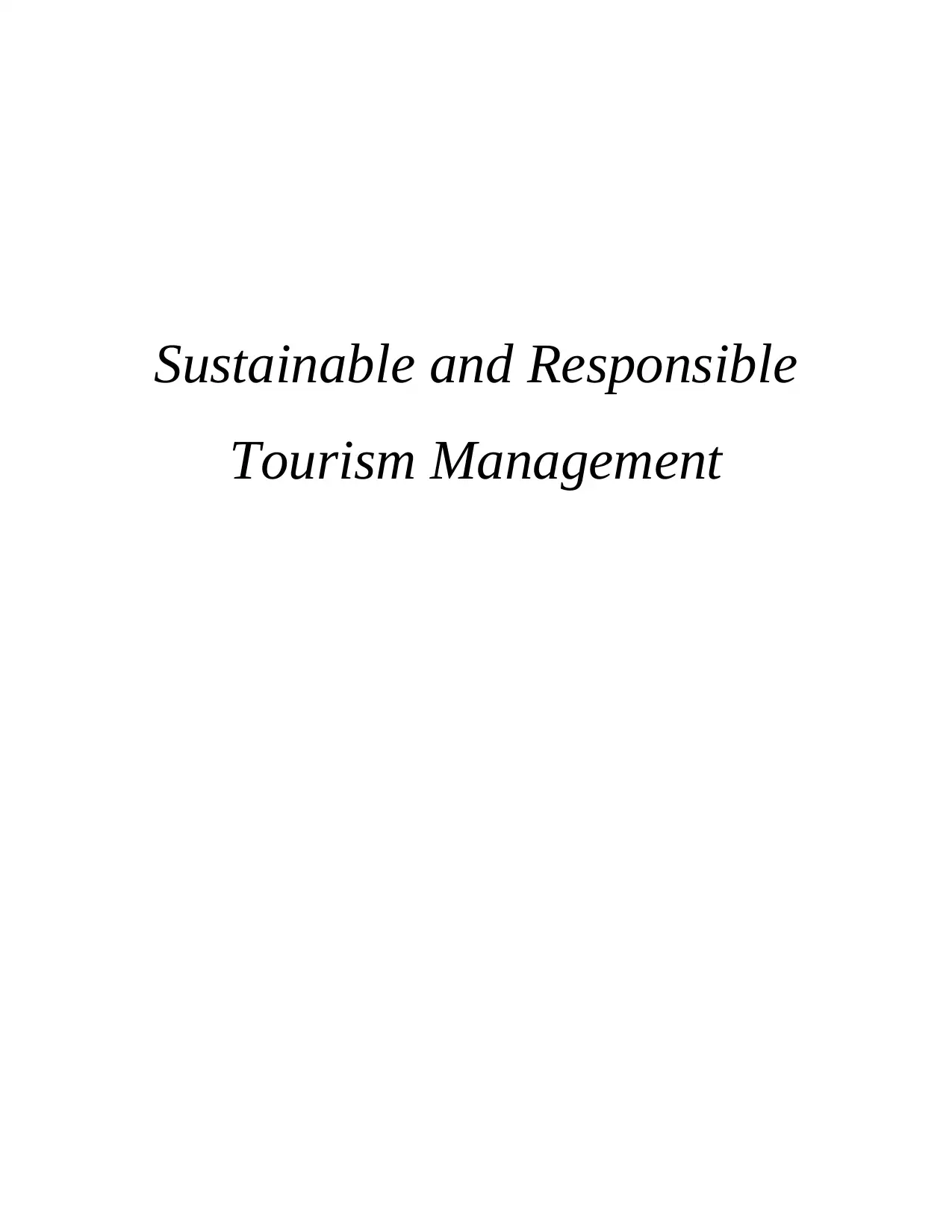
Sustainable and Responsible
Tourism Management
Tourism Management
Paraphrase This Document
Need a fresh take? Get an instant paraphrase of this document with our AI Paraphraser

Table of Contents
Introduction......................................................................................................................................3
P1. Explain how the concept of sustainable and responsible tourism has evolved.........................3
P2. Determine the role, function and mission of leading global organizations involved in the
promotion of sustainable and responsible tourism..........................................................................4
P3. Explore the purpose and principles of tourism development and planning to minimize the
adverse effects of tourism................................................................................................................6
P4. Evaluate the process of tourism development and planning, and the associated challenges and
problems, providing specific tourism examples..............................................................................7
P5. Investigate the impacts of tourism activity generated by a specific tourism attraction from an
economic, social, cultural and environmental perspective............................................................11
P6. Examine how principles of sustainability implemented by a specific tourism
business/attraction meet stakeholder requirements and expectations............................................12
P7. Evaluate how sustainability is being developed and managed in a range of tourist
destinations worldwide..................................................................................................................13
Conclusion.....................................................................................................................................16
References......................................................................................................................................17
Introduction......................................................................................................................................3
P1. Explain how the concept of sustainable and responsible tourism has evolved.........................3
P2. Determine the role, function and mission of leading global organizations involved in the
promotion of sustainable and responsible tourism..........................................................................4
P3. Explore the purpose and principles of tourism development and planning to minimize the
adverse effects of tourism................................................................................................................6
P4. Evaluate the process of tourism development and planning, and the associated challenges and
problems, providing specific tourism examples..............................................................................7
P5. Investigate the impacts of tourism activity generated by a specific tourism attraction from an
economic, social, cultural and environmental perspective............................................................11
P6. Examine how principles of sustainability implemented by a specific tourism
business/attraction meet stakeholder requirements and expectations............................................12
P7. Evaluate how sustainability is being developed and managed in a range of tourist
destinations worldwide..................................................................................................................13
Conclusion.....................................................................................................................................16
References......................................................................................................................................17
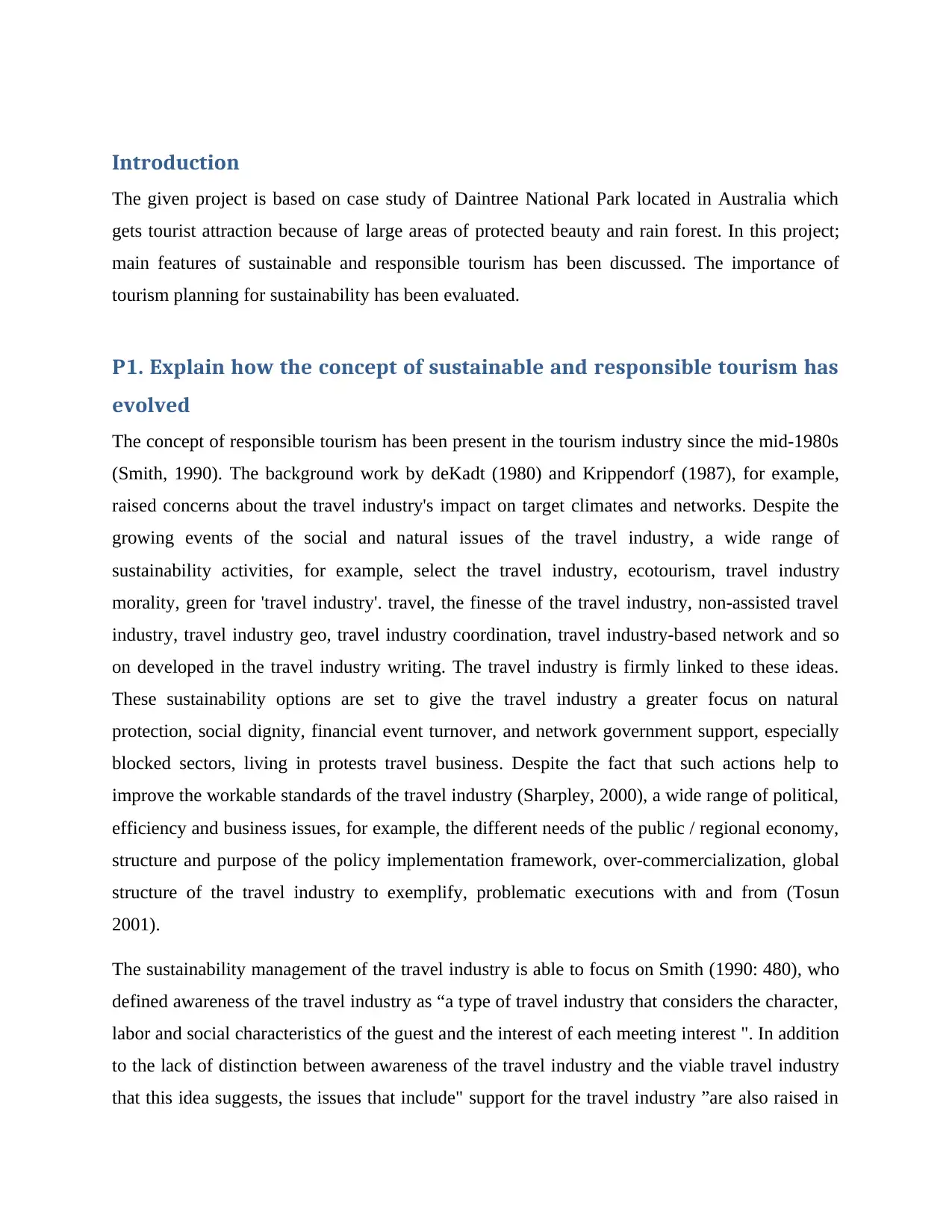
Introduction
The given project is based on case study of Daintree National Park located in Australia which
gets tourist attraction because of large areas of protected beauty and rain forest. In this project;
main features of sustainable and responsible tourism has been discussed. The importance of
tourism planning for sustainability has been evaluated.
P1. Explain how the concept of sustainable and responsible tourism has
evolved
The concept of responsible tourism has been present in the tourism industry since the mid-1980s
(Smith, 1990). The background work by deKadt (1980) and Krippendorf (1987), for example,
raised concerns about the travel industry's impact on target climates and networks. Despite the
growing events of the social and natural issues of the travel industry, a wide range of
sustainability activities, for example, select the travel industry, ecotourism, travel industry
morality, green for 'travel industry'. travel, the finesse of the travel industry, non-assisted travel
industry, travel industry geo, travel industry coordination, travel industry-based network and so
on developed in the travel industry writing. The travel industry is firmly linked to these ideas.
These sustainability options are set to give the travel industry a greater focus on natural
protection, social dignity, financial event turnover, and network government support, especially
blocked sectors, living in protests travel business. Despite the fact that such actions help to
improve the workable standards of the travel industry (Sharpley, 2000), a wide range of political,
efficiency and business issues, for example, the different needs of the public / regional economy,
structure and purpose of the policy implementation framework, over-commercialization, global
structure of the travel industry to exemplify, problematic executions with and from (Tosun
2001).
The sustainability management of the travel industry is able to focus on Smith (1990: 480), who
defined awareness of the travel industry as “a type of travel industry that considers the character,
labor and social characteristics of the guest and the interest of each meeting interest ". In addition
to the lack of distinction between awareness of the travel industry and the viable travel industry
that this idea suggests, the issues that include" support for the travel industry ”are also raised in
The given project is based on case study of Daintree National Park located in Australia which
gets tourist attraction because of large areas of protected beauty and rain forest. In this project;
main features of sustainable and responsible tourism has been discussed. The importance of
tourism planning for sustainability has been evaluated.
P1. Explain how the concept of sustainable and responsible tourism has
evolved
The concept of responsible tourism has been present in the tourism industry since the mid-1980s
(Smith, 1990). The background work by deKadt (1980) and Krippendorf (1987), for example,
raised concerns about the travel industry's impact on target climates and networks. Despite the
growing events of the social and natural issues of the travel industry, a wide range of
sustainability activities, for example, select the travel industry, ecotourism, travel industry
morality, green for 'travel industry'. travel, the finesse of the travel industry, non-assisted travel
industry, travel industry geo, travel industry coordination, travel industry-based network and so
on developed in the travel industry writing. The travel industry is firmly linked to these ideas.
These sustainability options are set to give the travel industry a greater focus on natural
protection, social dignity, financial event turnover, and network government support, especially
blocked sectors, living in protests travel business. Despite the fact that such actions help to
improve the workable standards of the travel industry (Sharpley, 2000), a wide range of political,
efficiency and business issues, for example, the different needs of the public / regional economy,
structure and purpose of the policy implementation framework, over-commercialization, global
structure of the travel industry to exemplify, problematic executions with and from (Tosun
2001).
The sustainability management of the travel industry is able to focus on Smith (1990: 480), who
defined awareness of the travel industry as “a type of travel industry that considers the character,
labor and social characteristics of the guest and the interest of each meeting interest ". In addition
to the lack of distinction between awareness of the travel industry and the viable travel industry
that this idea suggests, the issues that include" support for the travel industry ”are also raised in
⊘ This is a preview!⊘
Do you want full access?
Subscribe today to unlock all pages.

Trusted by 1+ million students worldwide
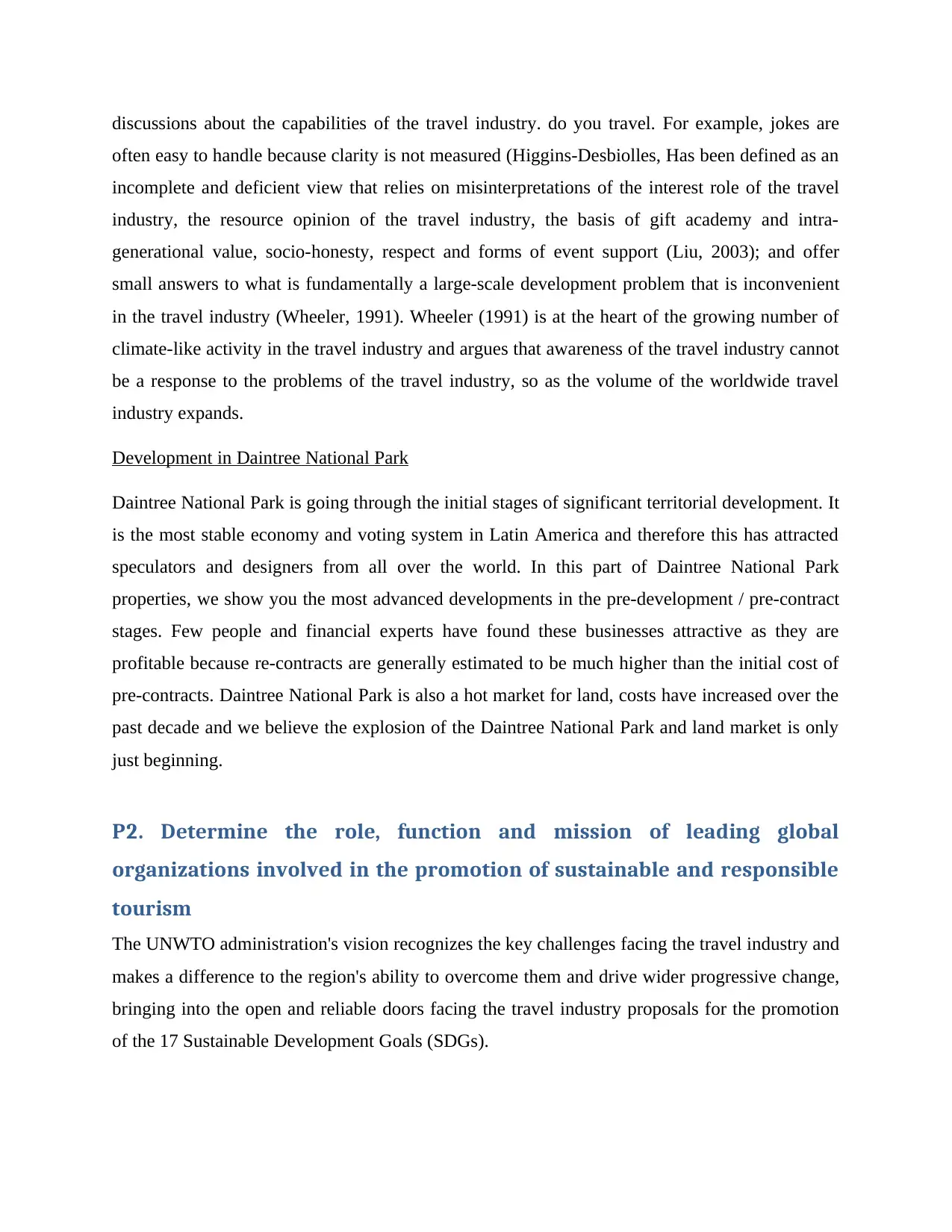
discussions about the capabilities of the travel industry. do you travel. For example, jokes are
often easy to handle because clarity is not measured (Higgins-Desbiolles, Has been defined as an
incomplete and deficient view that relies on misinterpretations of the interest role of the travel
industry, the resource opinion of the travel industry, the basis of gift academy and intra-
generational value, socio-honesty, respect and forms of event support (Liu, 2003); and offer
small answers to what is fundamentally a large-scale development problem that is inconvenient
in the travel industry (Wheeler, 1991). Wheeler (1991) is at the heart of the growing number of
climate-like activity in the travel industry and argues that awareness of the travel industry cannot
be a response to the problems of the travel industry, so as the volume of the worldwide travel
industry expands.
Development in Daintree National Park
Daintree National Park is going through the initial stages of significant territorial development. It
is the most stable economy and voting system in Latin America and therefore this has attracted
speculators and designers from all over the world. In this part of Daintree National Park
properties, we show you the most advanced developments in the pre-development / pre-contract
stages. Few people and financial experts have found these businesses attractive as they are
profitable because re-contracts are generally estimated to be much higher than the initial cost of
pre-contracts. Daintree National Park is also a hot market for land, costs have increased over the
past decade and we believe the explosion of the Daintree National Park and land market is only
just beginning.
P2. Determine the role, function and mission of leading global
organizations involved in the promotion of sustainable and responsible
tourism
The UNWTO administration's vision recognizes the key challenges facing the travel industry and
makes a difference to the region's ability to overcome them and drive wider progressive change,
bringing into the open and reliable doors facing the travel industry proposals for the promotion
of the 17 Sustainable Development Goals (SDGs).
often easy to handle because clarity is not measured (Higgins-Desbiolles, Has been defined as an
incomplete and deficient view that relies on misinterpretations of the interest role of the travel
industry, the resource opinion of the travel industry, the basis of gift academy and intra-
generational value, socio-honesty, respect and forms of event support (Liu, 2003); and offer
small answers to what is fundamentally a large-scale development problem that is inconvenient
in the travel industry (Wheeler, 1991). Wheeler (1991) is at the heart of the growing number of
climate-like activity in the travel industry and argues that awareness of the travel industry cannot
be a response to the problems of the travel industry, so as the volume of the worldwide travel
industry expands.
Development in Daintree National Park
Daintree National Park is going through the initial stages of significant territorial development. It
is the most stable economy and voting system in Latin America and therefore this has attracted
speculators and designers from all over the world. In this part of Daintree National Park
properties, we show you the most advanced developments in the pre-development / pre-contract
stages. Few people and financial experts have found these businesses attractive as they are
profitable because re-contracts are generally estimated to be much higher than the initial cost of
pre-contracts. Daintree National Park is also a hot market for land, costs have increased over the
past decade and we believe the explosion of the Daintree National Park and land market is only
just beginning.
P2. Determine the role, function and mission of leading global
organizations involved in the promotion of sustainable and responsible
tourism
The UNWTO administration's vision recognizes the key challenges facing the travel industry and
makes a difference to the region's ability to overcome them and drive wider progressive change,
bringing into the open and reliable doors facing the travel industry proposals for the promotion
of the 17 Sustainable Development Goals (SDGs).
Paraphrase This Document
Need a fresh take? Get an instant paraphrase of this document with our AI Paraphraser
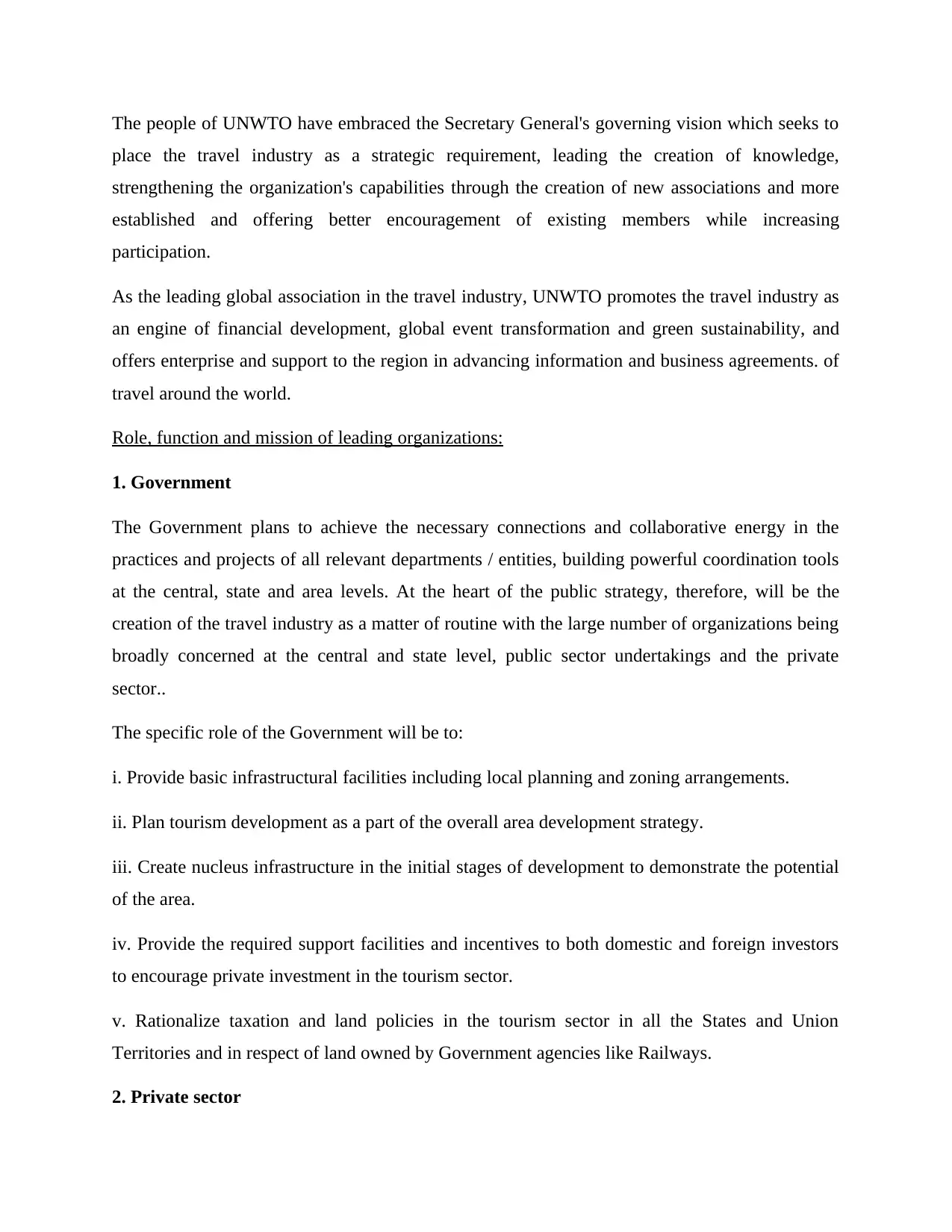
The people of UNWTO have embraced the Secretary General's governing vision which seeks to
place the travel industry as a strategic requirement, leading the creation of knowledge,
strengthening the organization's capabilities through the creation of new associations and more
established and offering better encouragement of existing members while increasing
participation.
As the leading global association in the travel industry, UNWTO promotes the travel industry as
an engine of financial development, global event transformation and green sustainability, and
offers enterprise and support to the region in advancing information and business agreements. of
travel around the world.
Role, function and mission of leading organizations:
1. Government
The Government plans to achieve the necessary connections and collaborative energy in the
practices and projects of all relevant departments / entities, building powerful coordination tools
at the central, state and area levels. At the heart of the public strategy, therefore, will be the
creation of the travel industry as a matter of routine with the large number of organizations being
broadly concerned at the central and state level, public sector undertakings and the private
sector..
The specific role of the Government will be to:
i. Provide basic infrastructural facilities including local planning and zoning arrangements.
ii. Plan tourism development as a part of the overall area development strategy.
iii. Create nucleus infrastructure in the initial stages of development to demonstrate the potential
of the area.
iv. Provide the required support facilities and incentives to both domestic and foreign investors
to encourage private investment in the tourism sector.
v. Rationalize taxation and land policies in the tourism sector in all the States and Union
Territories and in respect of land owned by Government agencies like Railways.
2. Private sector
place the travel industry as a strategic requirement, leading the creation of knowledge,
strengthening the organization's capabilities through the creation of new associations and more
established and offering better encouragement of existing members while increasing
participation.
As the leading global association in the travel industry, UNWTO promotes the travel industry as
an engine of financial development, global event transformation and green sustainability, and
offers enterprise and support to the region in advancing information and business agreements. of
travel around the world.
Role, function and mission of leading organizations:
1. Government
The Government plans to achieve the necessary connections and collaborative energy in the
practices and projects of all relevant departments / entities, building powerful coordination tools
at the central, state and area levels. At the heart of the public strategy, therefore, will be the
creation of the travel industry as a matter of routine with the large number of organizations being
broadly concerned at the central and state level, public sector undertakings and the private
sector..
The specific role of the Government will be to:
i. Provide basic infrastructural facilities including local planning and zoning arrangements.
ii. Plan tourism development as a part of the overall area development strategy.
iii. Create nucleus infrastructure in the initial stages of development to demonstrate the potential
of the area.
iv. Provide the required support facilities and incentives to both domestic and foreign investors
to encourage private investment in the tourism sector.
v. Rationalize taxation and land policies in the tourism sector in all the States and Union
Territories and in respect of land owned by Government agencies like Railways.
2. Private sector

The Tourism industry has developed into the largest fare industry internationally and the private
sector has played a leading role in this development worldwide. The private area needs to think
about the interest in the travel industry from a broad perspective and make the necessary offices
including convenience, timeshare, restaurants, entertainment offices, shopping premises and so
on there the specific areas for the advancement of the travel industry. Non-media exercises in all
airports, major stations and interstate transport, for example, cleaning and maintenance, baggage
transport, vehicles leaving offices and so on, should be open to passenger’s private
administration to expand the knowledge and benefit.
The specific role of the Private Sector will be to:
i. Build and manage the required tourist facilities in all places of tourist interest.
ii. Assume collective responsibility for laying down industry standards, ethics and fair practices.
iii. Ensure preservation and protection of tourist attractions and give lead in green practices.
iv. Sponsor maintenance of monuments, museums and parks and provision of public
conveniences and facilities.
v. Involve the local community in tourism projects and ensure that the benefits of tourism accrue
to them in right measure.
P3. Explore the purpose and principles of tourism development and
planning to minimize the adverse effects of tourism
Sustainable tourism is the form of tourism that deals with the problems of viewers, the travel
industry and hosting networks today without compromising the ability of people in the future to
deal with their own personal affairs.
According to the World Tourism Organization (WTO), the travel industry should:
1) Making exceptional use of natural resources which establish a vital role in the development of
the travel industry, maintain basic environmental cycles and help limit normal heritage and
biodiversity.
sector has played a leading role in this development worldwide. The private area needs to think
about the interest in the travel industry from a broad perspective and make the necessary offices
including convenience, timeshare, restaurants, entertainment offices, shopping premises and so
on there the specific areas for the advancement of the travel industry. Non-media exercises in all
airports, major stations and interstate transport, for example, cleaning and maintenance, baggage
transport, vehicles leaving offices and so on, should be open to passenger’s private
administration to expand the knowledge and benefit.
The specific role of the Private Sector will be to:
i. Build and manage the required tourist facilities in all places of tourist interest.
ii. Assume collective responsibility for laying down industry standards, ethics and fair practices.
iii. Ensure preservation and protection of tourist attractions and give lead in green practices.
iv. Sponsor maintenance of monuments, museums and parks and provision of public
conveniences and facilities.
v. Involve the local community in tourism projects and ensure that the benefits of tourism accrue
to them in right measure.
P3. Explore the purpose and principles of tourism development and
planning to minimize the adverse effects of tourism
Sustainable tourism is the form of tourism that deals with the problems of viewers, the travel
industry and hosting networks today without compromising the ability of people in the future to
deal with their own personal affairs.
According to the World Tourism Organization (WTO), the travel industry should:
1) Making exceptional use of natural resources which establish a vital role in the development of
the travel industry, maintain basic environmental cycles and help limit normal heritage and
biodiversity.
⊘ This is a preview!⊘
Do you want full access?
Subscribe today to unlock all pages.

Trusted by 1+ million students worldwide
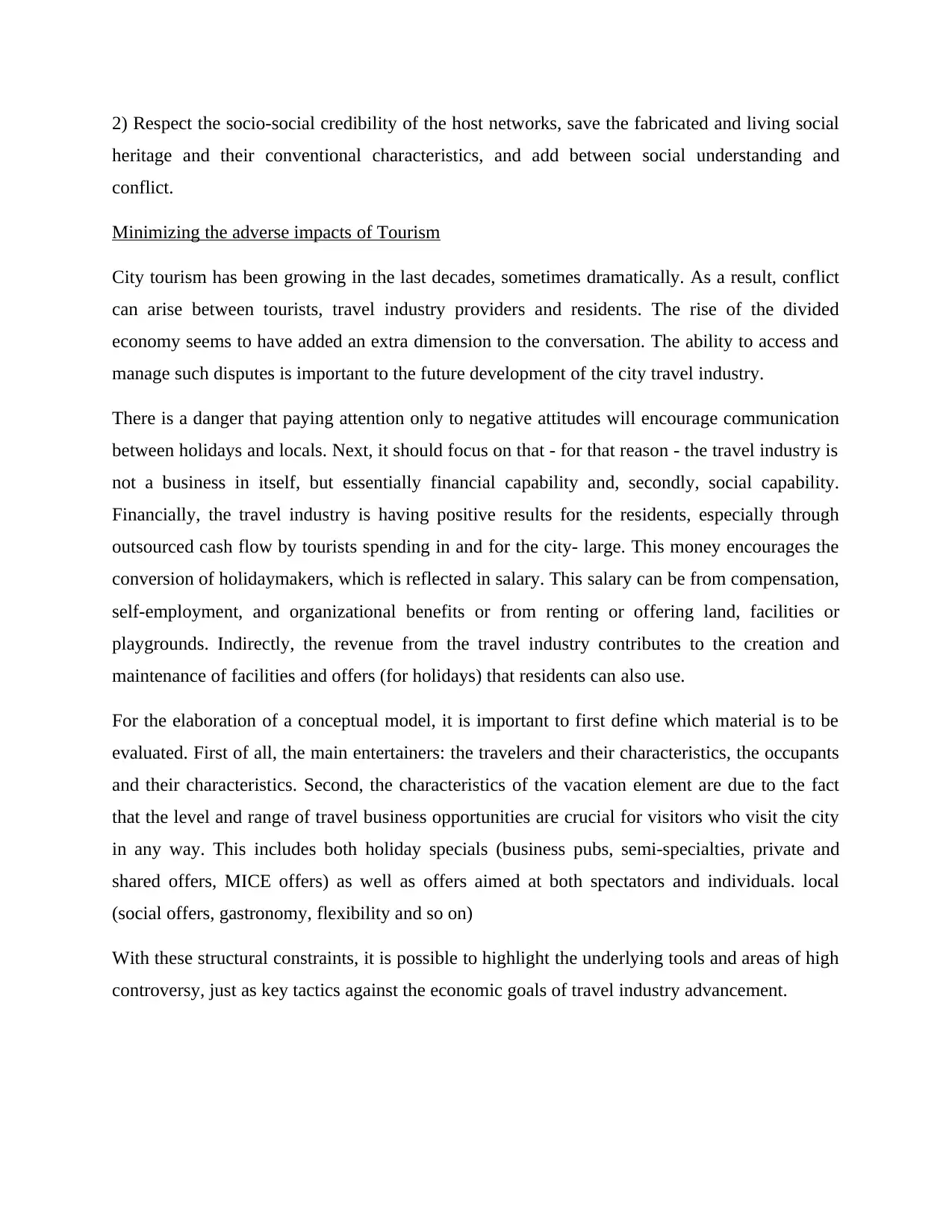
2) Respect the socio-social credibility of the host networks, save the fabricated and living social
heritage and their conventional characteristics, and add between social understanding and
conflict.
Minimizing the adverse impacts of Tourism
City tourism has been growing in the last decades, sometimes dramatically. As a result, conflict
can arise between tourists, travel industry providers and residents. The rise of the divided
economy seems to have added an extra dimension to the conversation. The ability to access and
manage such disputes is important to the future development of the city travel industry.
There is a danger that paying attention only to negative attitudes will encourage communication
between holidays and locals. Next, it should focus on that - for that reason - the travel industry is
not a business in itself, but essentially financial capability and, secondly, social capability.
Financially, the travel industry is having positive results for the residents, especially through
outsourced cash flow by tourists spending in and for the city- large. This money encourages the
conversion of holidaymakers, which is reflected in salary. This salary can be from compensation,
self-employment, and organizational benefits or from renting or offering land, facilities or
playgrounds. Indirectly, the revenue from the travel industry contributes to the creation and
maintenance of facilities and offers (for holidays) that residents can also use.
For the elaboration of a conceptual model, it is important to first define which material is to be
evaluated. First of all, the main entertainers: the travelers and their characteristics, the occupants
and their characteristics. Second, the characteristics of the vacation element are due to the fact
that the level and range of travel business opportunities are crucial for visitors who visit the city
in any way. This includes both holiday specials (business pubs, semi-specialties, private and
shared offers, MICE offers) as well as offers aimed at both spectators and individuals. local
(social offers, gastronomy, flexibility and so on)
With these structural constraints, it is possible to highlight the underlying tools and areas of high
controversy, just as key tactics against the economic goals of travel industry advancement.
heritage and their conventional characteristics, and add between social understanding and
conflict.
Minimizing the adverse impacts of Tourism
City tourism has been growing in the last decades, sometimes dramatically. As a result, conflict
can arise between tourists, travel industry providers and residents. The rise of the divided
economy seems to have added an extra dimension to the conversation. The ability to access and
manage such disputes is important to the future development of the city travel industry.
There is a danger that paying attention only to negative attitudes will encourage communication
between holidays and locals. Next, it should focus on that - for that reason - the travel industry is
not a business in itself, but essentially financial capability and, secondly, social capability.
Financially, the travel industry is having positive results for the residents, especially through
outsourced cash flow by tourists spending in and for the city- large. This money encourages the
conversion of holidaymakers, which is reflected in salary. This salary can be from compensation,
self-employment, and organizational benefits or from renting or offering land, facilities or
playgrounds. Indirectly, the revenue from the travel industry contributes to the creation and
maintenance of facilities and offers (for holidays) that residents can also use.
For the elaboration of a conceptual model, it is important to first define which material is to be
evaluated. First of all, the main entertainers: the travelers and their characteristics, the occupants
and their characteristics. Second, the characteristics of the vacation element are due to the fact
that the level and range of travel business opportunities are crucial for visitors who visit the city
in any way. This includes both holiday specials (business pubs, semi-specialties, private and
shared offers, MICE offers) as well as offers aimed at both spectators and individuals. local
(social offers, gastronomy, flexibility and so on)
With these structural constraints, it is possible to highlight the underlying tools and areas of high
controversy, just as key tactics against the economic goals of travel industry advancement.
Paraphrase This Document
Need a fresh take? Get an instant paraphrase of this document with our AI Paraphraser
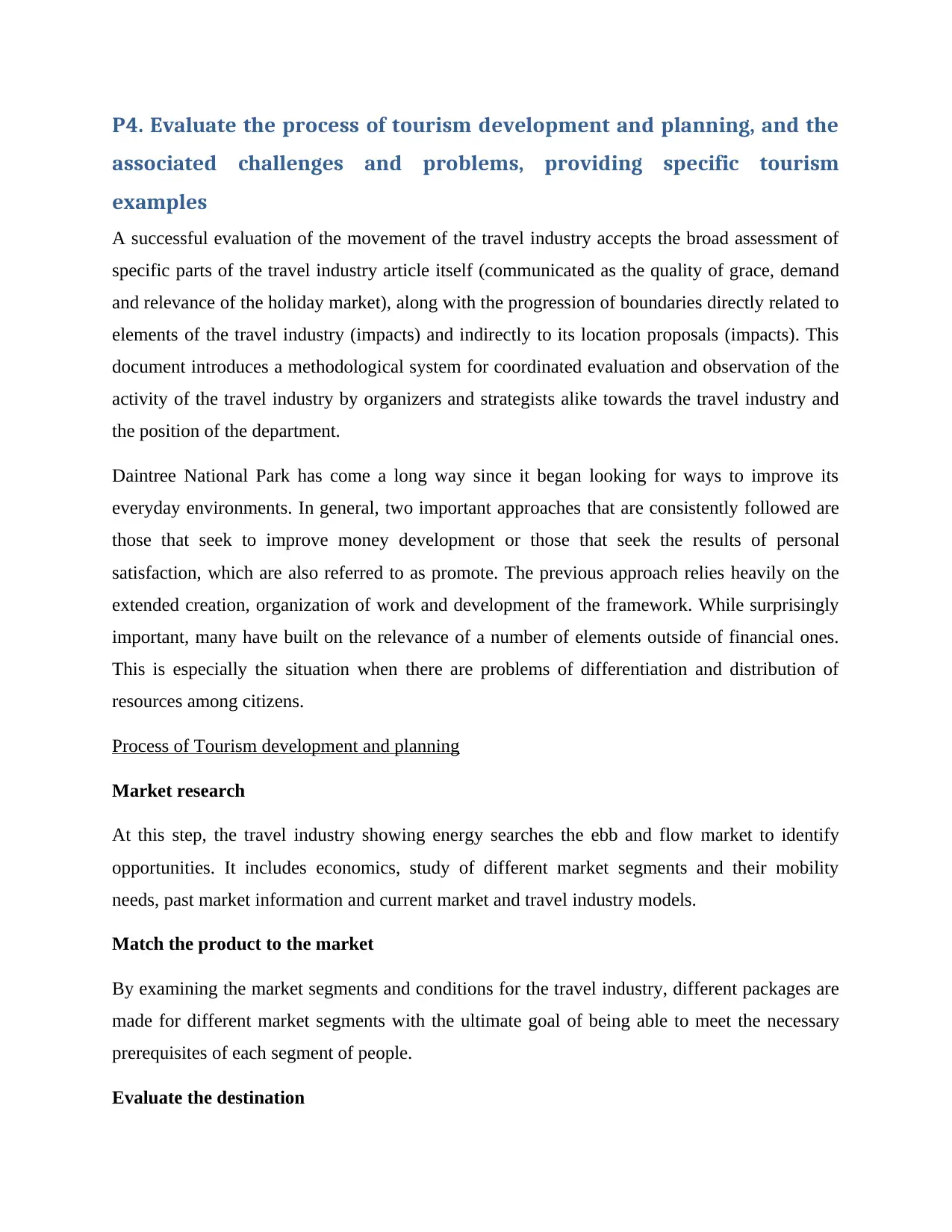
P4. Evaluate the process of tourism development and planning, and the
associated challenges and problems, providing specific tourism
examples
A successful evaluation of the movement of the travel industry accepts the broad assessment of
specific parts of the travel industry article itself (communicated as the quality of grace, demand
and relevance of the holiday market), along with the progression of boundaries directly related to
elements of the travel industry (impacts) and indirectly to its location proposals (impacts). This
document introduces a methodological system for coordinated evaluation and observation of the
activity of the travel industry by organizers and strategists alike towards the travel industry and
the position of the department.
Daintree National Park has come a long way since it began looking for ways to improve its
everyday environments. In general, two important approaches that are consistently followed are
those that seek to improve money development or those that seek the results of personal
satisfaction, which are also referred to as promote. The previous approach relies heavily on the
extended creation, organization of work and development of the framework. While surprisingly
important, many have built on the relevance of a number of elements outside of financial ones.
This is especially the situation when there are problems of differentiation and distribution of
resources among citizens.
Process of Tourism development and planning
Market research
At this step, the travel industry showing energy searches the ebb and flow market to identify
opportunities. It includes economics, study of different market segments and their mobility
needs, past market information and current market and travel industry models.
Match the product to the market
By examining the market segments and conditions for the travel industry, different packages are
made for different market segments with the ultimate goal of being able to meet the necessary
prerequisites of each segment of people.
Evaluate the destination
associated challenges and problems, providing specific tourism
examples
A successful evaluation of the movement of the travel industry accepts the broad assessment of
specific parts of the travel industry article itself (communicated as the quality of grace, demand
and relevance of the holiday market), along with the progression of boundaries directly related to
elements of the travel industry (impacts) and indirectly to its location proposals (impacts). This
document introduces a methodological system for coordinated evaluation and observation of the
activity of the travel industry by organizers and strategists alike towards the travel industry and
the position of the department.
Daintree National Park has come a long way since it began looking for ways to improve its
everyday environments. In general, two important approaches that are consistently followed are
those that seek to improve money development or those that seek the results of personal
satisfaction, which are also referred to as promote. The previous approach relies heavily on the
extended creation, organization of work and development of the framework. While surprisingly
important, many have built on the relevance of a number of elements outside of financial ones.
This is especially the situation when there are problems of differentiation and distribution of
resources among citizens.
Process of Tourism development and planning
Market research
At this step, the travel industry showing energy searches the ebb and flow market to identify
opportunities. It includes economics, study of different market segments and their mobility
needs, past market information and current market and travel industry models.
Match the product to the market
By examining the market segments and conditions for the travel industry, different packages are
made for different market segments with the ultimate goal of being able to meet the necessary
prerequisites of each segment of people.
Evaluate the destination

As complaints structure the foundation of item development, item promotion power achieves the
travel industry goal planned to assess the travel industry's potential and its potential to have an
impact and caters to vacations, key places and its weak spots. An audit is carried out to
determine whether the target meets pre-existing accommodation, attractions, activities or
facilities. It is similarly examined for the simplicity of Access.
Understanding the role of stakeholders
The development of articles in the travel industry is the result of synergistic efforts of different
partners. It takes into account the different entities of all participants in the private and public
sectors, DMOs, tourism and affiliates, and their individual actions in creating or building a piece.
of travel business. Partner meetings are led to create a business plan. The objectives of the
initiative are set to recognize the long-term vision, medium-term business plans and transition
progress assessments.
Product Building
In this progress, the item has been implemented using the required funds and capacity advice to
produce centralized information sources (offices and upgrades) and halfway results
(administrations). It covers the progress of the goal plan and the help with unique exercises and
meetings.
Marketing & Promotion
The useful and passionate benefits of the travel resort industry have been brought to market.
Exhibitors make leaflets, post business rumors, and report to the media to target and promote the
event on TV and radio. They also use a number of other promotion strategies to build the
potential of the item.
Provides human and technical resources
It involves the provision of a talented workforce and contemporary innovation to feed holiday
needs in a productive way, to deal appropriately with all activities related to the travel industry in
the area and to talk to employees without any problem.
Issues and Challenges
travel industry goal planned to assess the travel industry's potential and its potential to have an
impact and caters to vacations, key places and its weak spots. An audit is carried out to
determine whether the target meets pre-existing accommodation, attractions, activities or
facilities. It is similarly examined for the simplicity of Access.
Understanding the role of stakeholders
The development of articles in the travel industry is the result of synergistic efforts of different
partners. It takes into account the different entities of all participants in the private and public
sectors, DMOs, tourism and affiliates, and their individual actions in creating or building a piece.
of travel business. Partner meetings are led to create a business plan. The objectives of the
initiative are set to recognize the long-term vision, medium-term business plans and transition
progress assessments.
Product Building
In this progress, the item has been implemented using the required funds and capacity advice to
produce centralized information sources (offices and upgrades) and halfway results
(administrations). It covers the progress of the goal plan and the help with unique exercises and
meetings.
Marketing & Promotion
The useful and passionate benefits of the travel resort industry have been brought to market.
Exhibitors make leaflets, post business rumors, and report to the media to target and promote the
event on TV and radio. They also use a number of other promotion strategies to build the
potential of the item.
Provides human and technical resources
It involves the provision of a talented workforce and contemporary innovation to feed holiday
needs in a productive way, to deal appropriately with all activities related to the travel industry in
the area and to talk to employees without any problem.
Issues and Challenges
⊘ This is a preview!⊘
Do you want full access?
Subscribe today to unlock all pages.

Trusted by 1+ million students worldwide
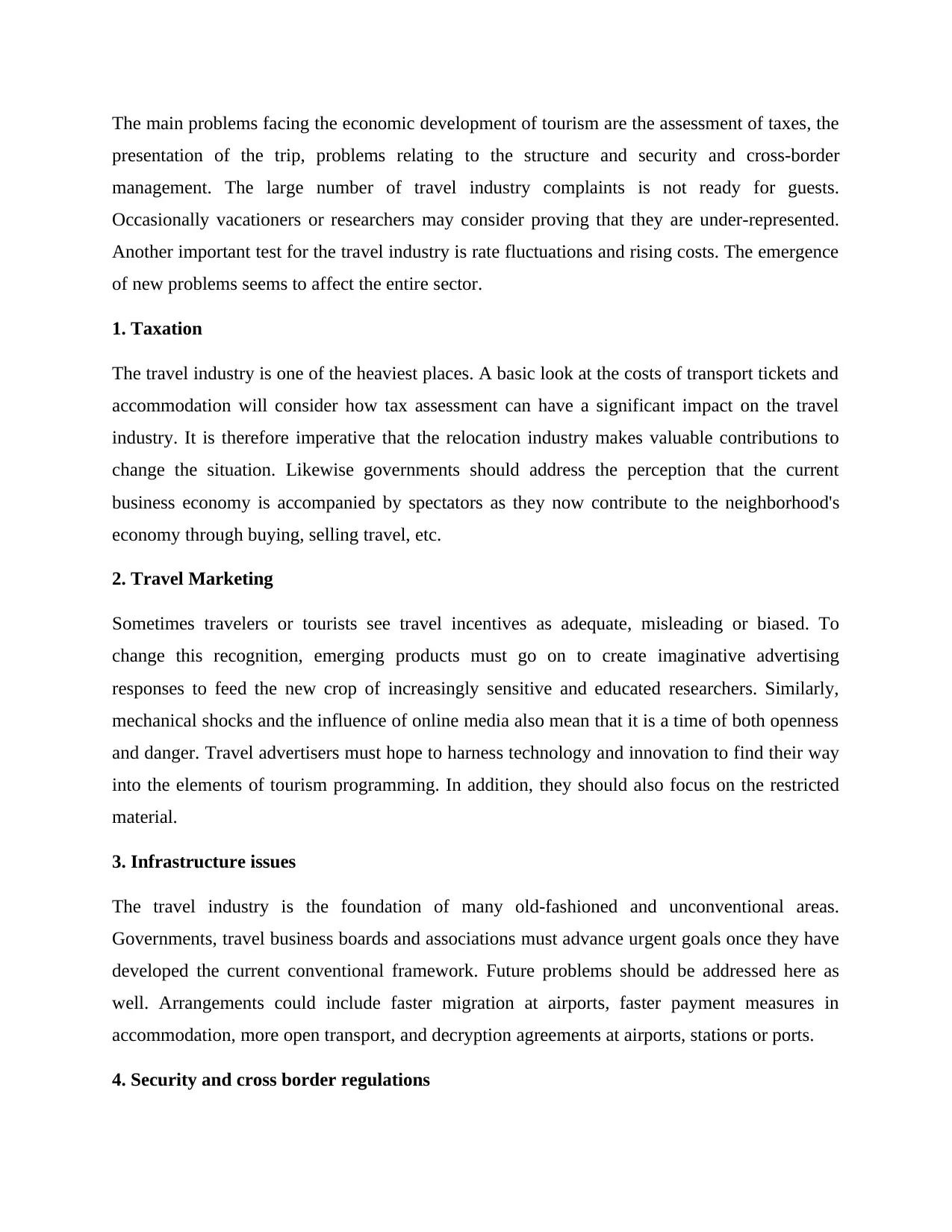
The main problems facing the economic development of tourism are the assessment of taxes, the
presentation of the trip, problems relating to the structure and security and cross-border
management. The large number of travel industry complaints is not ready for guests.
Occasionally vacationers or researchers may consider proving that they are under-represented.
Another important test for the travel industry is rate fluctuations and rising costs. The emergence
of new problems seems to affect the entire sector.
1. Taxation
The travel industry is one of the heaviest places. A basic look at the costs of transport tickets and
accommodation will consider how tax assessment can have a significant impact on the travel
industry. It is therefore imperative that the relocation industry makes valuable contributions to
change the situation. Likewise governments should address the perception that the current
business economy is accompanied by spectators as they now contribute to the neighborhood's
economy through buying, selling travel, etc.
2. Travel Marketing
Sometimes travelers or tourists see travel incentives as adequate, misleading or biased. To
change this recognition, emerging products must go on to create imaginative advertising
responses to feed the new crop of increasingly sensitive and educated researchers. Similarly,
mechanical shocks and the influence of online media also mean that it is a time of both openness
and danger. Travel advertisers must hope to harness technology and innovation to find their way
into the elements of tourism programming. In addition, they should also focus on the restricted
material.
3. Infrastructure issues
The travel industry is the foundation of many old-fashioned and unconventional areas.
Governments, travel business boards and associations must advance urgent goals once they have
developed the current conventional framework. Future problems should be addressed here as
well. Arrangements could include faster migration at airports, faster payment measures in
accommodation, more open transport, and decryption agreements at airports, stations or ports.
4. Security and cross border regulations
presentation of the trip, problems relating to the structure and security and cross-border
management. The large number of travel industry complaints is not ready for guests.
Occasionally vacationers or researchers may consider proving that they are under-represented.
Another important test for the travel industry is rate fluctuations and rising costs. The emergence
of new problems seems to affect the entire sector.
1. Taxation
The travel industry is one of the heaviest places. A basic look at the costs of transport tickets and
accommodation will consider how tax assessment can have a significant impact on the travel
industry. It is therefore imperative that the relocation industry makes valuable contributions to
change the situation. Likewise governments should address the perception that the current
business economy is accompanied by spectators as they now contribute to the neighborhood's
economy through buying, selling travel, etc.
2. Travel Marketing
Sometimes travelers or tourists see travel incentives as adequate, misleading or biased. To
change this recognition, emerging products must go on to create imaginative advertising
responses to feed the new crop of increasingly sensitive and educated researchers. Similarly,
mechanical shocks and the influence of online media also mean that it is a time of both openness
and danger. Travel advertisers must hope to harness technology and innovation to find their way
into the elements of tourism programming. In addition, they should also focus on the restricted
material.
3. Infrastructure issues
The travel industry is the foundation of many old-fashioned and unconventional areas.
Governments, travel business boards and associations must advance urgent goals once they have
developed the current conventional framework. Future problems should be addressed here as
well. Arrangements could include faster migration at airports, faster payment measures in
accommodation, more open transport, and decryption agreements at airports, stations or ports.
4. Security and cross border regulations
Paraphrase This Document
Need a fresh take? Get an instant paraphrase of this document with our AI Paraphraser
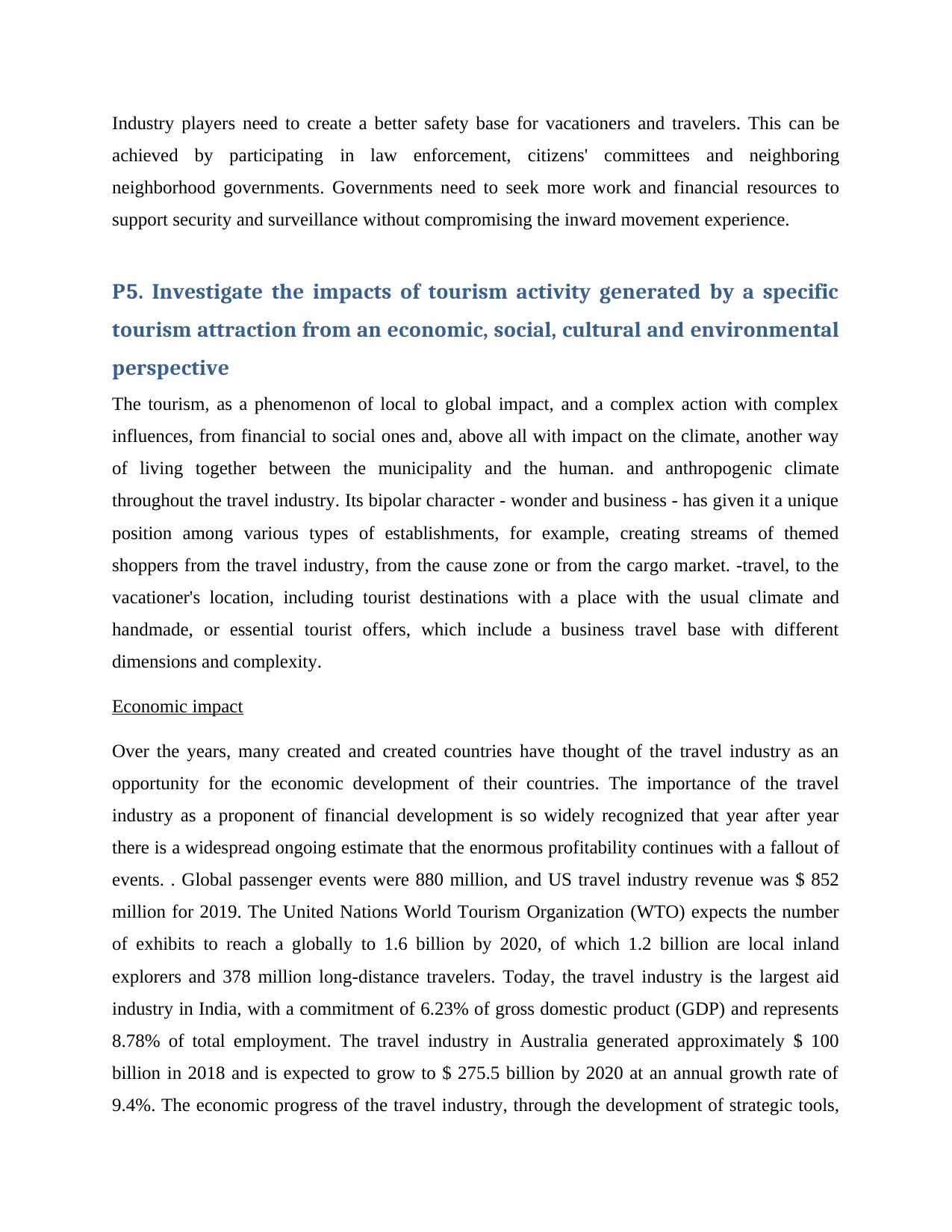
Industry players need to create a better safety base for vacationers and travelers. This can be
achieved by participating in law enforcement, citizens' committees and neighboring
neighborhood governments. Governments need to seek more work and financial resources to
support security and surveillance without compromising the inward movement experience.
P5. Investigate the impacts of tourism activity generated by a specific
tourism attraction from an economic, social, cultural and environmental
perspective
The tourism, as a phenomenon of local to global impact, and a complex action with complex
influences, from financial to social ones and, above all with impact on the climate, another way
of living together between the municipality and the human. and anthropogenic climate
throughout the travel industry. Its bipolar character - wonder and business - has given it a unique
position among various types of establishments, for example, creating streams of themed
shoppers from the travel industry, from the cause zone or from the cargo market. -travel, to the
vacationer's location, including tourist destinations with a place with the usual climate and
handmade, or essential tourist offers, which include a business travel base with different
dimensions and complexity.
Economic impact
Over the years, many created and created countries have thought of the travel industry as an
opportunity for the economic development of their countries. The importance of the travel
industry as a proponent of financial development is so widely recognized that year after year
there is a widespread ongoing estimate that the enormous profitability continues with a fallout of
events. . Global passenger events were 880 million, and US travel industry revenue was $ 852
million for 2019. The United Nations World Tourism Organization (WTO) expects the number
of exhibits to reach a globally to 1.6 billion by 2020, of which 1.2 billion are local inland
explorers and 378 million long-distance travelers. Today, the travel industry is the largest aid
industry in India, with a commitment of 6.23% of gross domestic product (GDP) and represents
8.78% of total employment. The travel industry in Australia generated approximately $ 100
billion in 2018 and is expected to grow to $ 275.5 billion by 2020 at an annual growth rate of
9.4%. The economic progress of the travel industry, through the development of strategic tools,
achieved by participating in law enforcement, citizens' committees and neighboring
neighborhood governments. Governments need to seek more work and financial resources to
support security and surveillance without compromising the inward movement experience.
P5. Investigate the impacts of tourism activity generated by a specific
tourism attraction from an economic, social, cultural and environmental
perspective
The tourism, as a phenomenon of local to global impact, and a complex action with complex
influences, from financial to social ones and, above all with impact on the climate, another way
of living together between the municipality and the human. and anthropogenic climate
throughout the travel industry. Its bipolar character - wonder and business - has given it a unique
position among various types of establishments, for example, creating streams of themed
shoppers from the travel industry, from the cause zone or from the cargo market. -travel, to the
vacationer's location, including tourist destinations with a place with the usual climate and
handmade, or essential tourist offers, which include a business travel base with different
dimensions and complexity.
Economic impact
Over the years, many created and created countries have thought of the travel industry as an
opportunity for the economic development of their countries. The importance of the travel
industry as a proponent of financial development is so widely recognized that year after year
there is a widespread ongoing estimate that the enormous profitability continues with a fallout of
events. . Global passenger events were 880 million, and US travel industry revenue was $ 852
million for 2019. The United Nations World Tourism Organization (WTO) expects the number
of exhibits to reach a globally to 1.6 billion by 2020, of which 1.2 billion are local inland
explorers and 378 million long-distance travelers. Today, the travel industry is the largest aid
industry in India, with a commitment of 6.23% of gross domestic product (GDP) and represents
8.78% of total employment. The travel industry in Australia generated approximately $ 100
billion in 2018 and is expected to grow to $ 275.5 billion by 2020 at an annual growth rate of
9.4%. The economic progress of the travel industry, through the development of strategic tools,
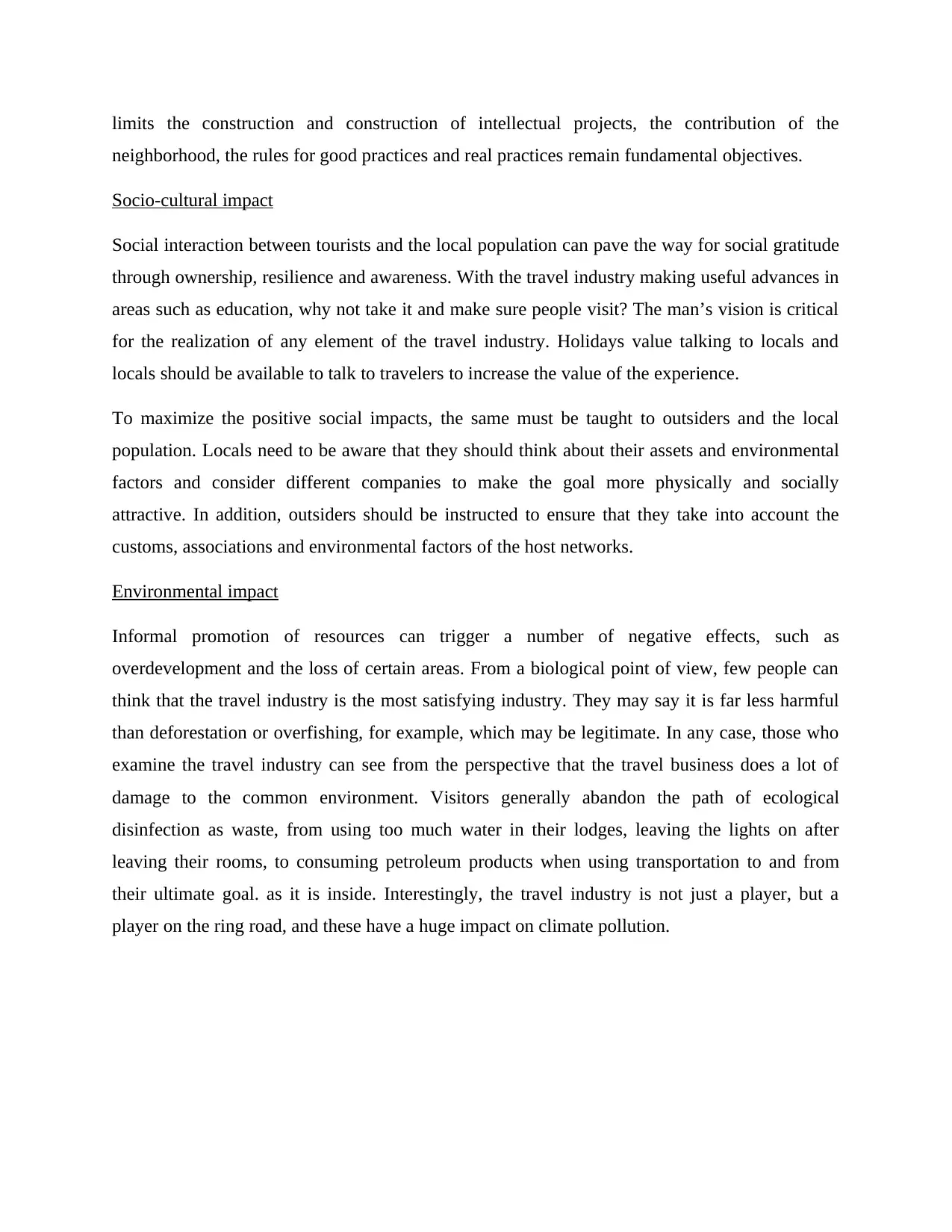
limits the construction and construction of intellectual projects, the contribution of the
neighborhood, the rules for good practices and real practices remain fundamental objectives.
Socio-cultural impact
Social interaction between tourists and the local population can pave the way for social gratitude
through ownership, resilience and awareness. With the travel industry making useful advances in
areas such as education, why not take it and make sure people visit? The man’s vision is critical
for the realization of any element of the travel industry. Holidays value talking to locals and
locals should be available to talk to travelers to increase the value of the experience.
To maximize the positive social impacts, the same must be taught to outsiders and the local
population. Locals need to be aware that they should think about their assets and environmental
factors and consider different companies to make the goal more physically and socially
attractive. In addition, outsiders should be instructed to ensure that they take into account the
customs, associations and environmental factors of the host networks.
Environmental impact
Informal promotion of resources can trigger a number of negative effects, such as
overdevelopment and the loss of certain areas. From a biological point of view, few people can
think that the travel industry is the most satisfying industry. They may say it is far less harmful
than deforestation or overfishing, for example, which may be legitimate. In any case, those who
examine the travel industry can see from the perspective that the travel business does a lot of
damage to the common environment. Visitors generally abandon the path of ecological
disinfection as waste, from using too much water in their lodges, leaving the lights on after
leaving their rooms, to consuming petroleum products when using transportation to and from
their ultimate goal. as it is inside. Interestingly, the travel industry is not just a player, but a
player on the ring road, and these have a huge impact on climate pollution.
neighborhood, the rules for good practices and real practices remain fundamental objectives.
Socio-cultural impact
Social interaction between tourists and the local population can pave the way for social gratitude
through ownership, resilience and awareness. With the travel industry making useful advances in
areas such as education, why not take it and make sure people visit? The man’s vision is critical
for the realization of any element of the travel industry. Holidays value talking to locals and
locals should be available to talk to travelers to increase the value of the experience.
To maximize the positive social impacts, the same must be taught to outsiders and the local
population. Locals need to be aware that they should think about their assets and environmental
factors and consider different companies to make the goal more physically and socially
attractive. In addition, outsiders should be instructed to ensure that they take into account the
customs, associations and environmental factors of the host networks.
Environmental impact
Informal promotion of resources can trigger a number of negative effects, such as
overdevelopment and the loss of certain areas. From a biological point of view, few people can
think that the travel industry is the most satisfying industry. They may say it is far less harmful
than deforestation or overfishing, for example, which may be legitimate. In any case, those who
examine the travel industry can see from the perspective that the travel business does a lot of
damage to the common environment. Visitors generally abandon the path of ecological
disinfection as waste, from using too much water in their lodges, leaving the lights on after
leaving their rooms, to consuming petroleum products when using transportation to and from
their ultimate goal. as it is inside. Interestingly, the travel industry is not just a player, but a
player on the ring road, and these have a huge impact on climate pollution.
⊘ This is a preview!⊘
Do you want full access?
Subscribe today to unlock all pages.

Trusted by 1+ million students worldwide
1 out of 17
Related Documents
Your All-in-One AI-Powered Toolkit for Academic Success.
+13062052269
info@desklib.com
Available 24*7 on WhatsApp / Email
![[object Object]](/_next/static/media/star-bottom.7253800d.svg)
Unlock your academic potential
Copyright © 2020–2025 A2Z Services. All Rights Reserved. Developed and managed by ZUCOL.


![Sustainable and Responsible Tourism Management Report - [Course Name]](/_next/image/?url=https%3A%2F%2Fdesklib.com%2Fmedia%2Fimages%2Ftt%2F97543c1e789843e897460d59424ee454.jpg&w=256&q=75)


